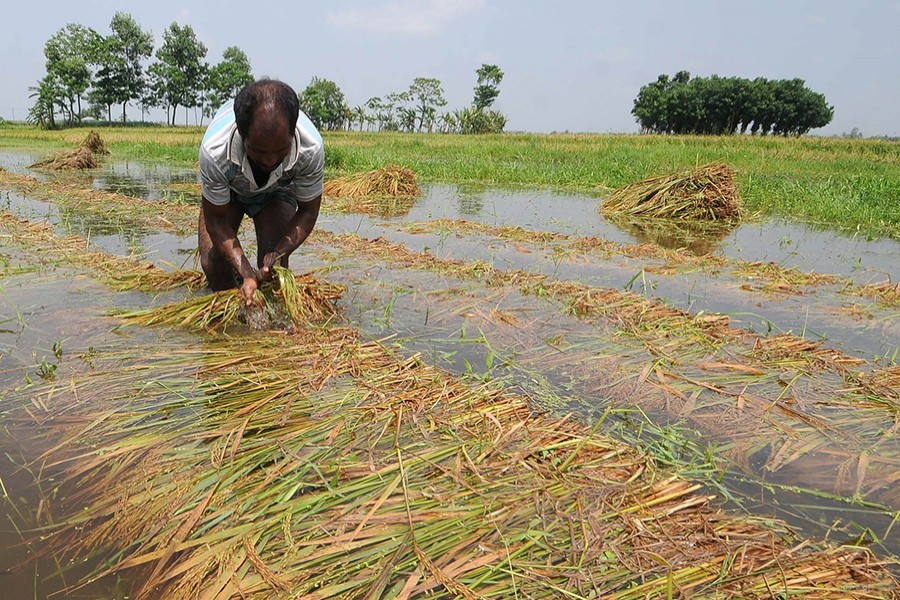The use of groundwater in real terms would be much less than what has been predicted earlier, and that it does not deplete the water table as apprehended earlier.
The latest researches on the ground water levels in Bangladesh have made such revelations at a time when concerns were deepening among the policymakers due to excessive mining of groundwater for irrigation purposes.
The findings shared at a webinar on Sunday showed that the water usage for one kilogramme of paddy production in Boro season is only 1,606 litres on average and 40 per cent of the used water refills the groundwater level through percolation and seepage.
So, studies suggested, the actual use of water for one kg of Boro output would be only 550-650 litres, which is much lesser than 3,000-5,000 litres as estimated previously.
The Bangladesh Rice Research Institute (BRRI) organised the webinar styled 'Groundwater Sustainability and Rice Production in North-West Bangladesh'. Two studies were presented at the webinar.
The BRRI in collaboration with the Commonwealth Scientific and Industrial Research Organization (CSIRO) and University of Southern Queensland (USQ) and ACIAR, Australian Aid have conducted different studies on the issue in the last five years in Barind and northern regions.
Chief scientific officer BRRI Irrigation and Water Management Department Dr Md Moniruzzaman presented the research report titled "How much water required to produce 1.0 kg of Boro rice?" while principal research scientist of CSIRO, Australia Mohammed Mainuddin presented the document on 'Sustaining groundwater irrigation for food security in the northwest region of Bangladesh".
Taking part in the discussion, agriculture minister Dr Muhammad Abdur Razzaque pointed out that there were confusions about water usage for Boro production, but these latest studies have helped remove such perception thanks to the new findings.
He said the government already has adopted irrigation management to minimise the groundwater usage for irrigation and these new studies will further help us take appropriate policies.
Professor Emeritus and former vice chancellor of Bangladesh Agricultural University Dr MA Sattar Mandol, however, pointed out that Boro cultivation was not the lone factor responsible for the groundwater level depletion in the north-western part of the country.
"Due to minimum flow of water in the rivers, canals and beels in the north-west during the dry season, a portion of the groundwater flows into the rivers as its base-flow," he said.
He also pointed out that the flood water first fills the gap of the groundwater that was extracted, thus reducing the intensity of the flood.
Former director general of Department of Agricultural Extension (DAE) Hamidur Rahman said that in order to manage sustainable groundwater in the north-west, it is necessary to increase the use of surface water through adopting an integrated approach.
"Water conservation in rivers and canals would enable successful cultivation of paddy and other crops in the north-west," he said.
BRRI director general Dr Shahjahan Kabir said the perception that the groundwater level is going down due to the Boro irrigation across the country was not correct. It can happen only in a few areas of the Barind region, he added.
He also pointed out that the underground aquifers act as a water reservoir. So, there is no need to be distracted by such misinformation, he said.
Agriculture secretary Md Sayedul Islam, executive chairman of the Bangladesh Agricultural Research Council Shaikh Mohammad Bokhtiar, chairman of Bangladesh Agriculture Development Corporation AFM Hayatullah, director general of DAE Md Benazir Alam and executive director of Barind Multipurpose Development Authority Md Abdur Rashid also spoke among others.
The studies also showed that the Boro cultivation area in the north-west remained almost static at 1.6 million hectares for the last one decade, but the production increased due to increased use of the high-yielding varieties.
The studies recommended that use of the high-yielding varieties and adopting modern cropping pattern-based cultivation could further increase the productivity of the land and facilitate economic use of the crop water.


